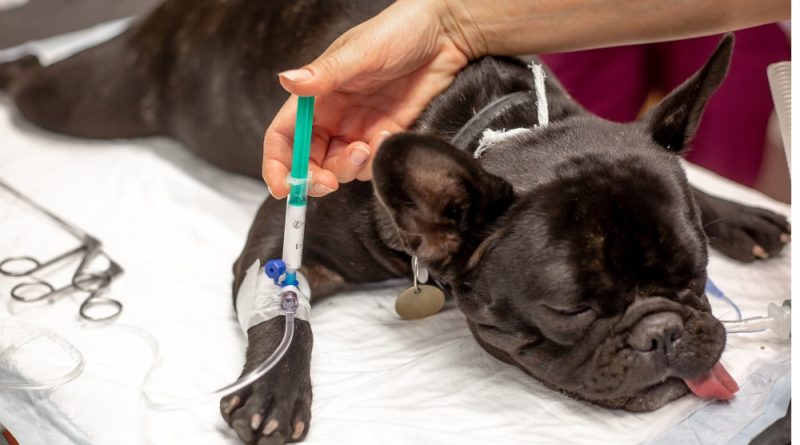Get to know the types of anesthesia available for pets
Some veterinary procedures are relatively quick and easy, such as castration surgery (especially in males) and tartar removal. Nevertheless, you may have heard that they are risky, mainly due to the need to anesthetize the dog.
Anesthesia is essential so that the pet does not feel pain, in addition to keeping our friend unconscious and still during the procedure.
After all, unlike us, for example, dogs don’t know they should stay still while brushing their teeth. So, are you ready to learn more about the types of anesthesia, their risks, and how they work?
Types of general anesthesia: injection and inhalation
In humans, the use of local anesthesia during simple procedures, such as wart removal or even cavity treatment, is common. This is possible because, aware of the situation, we can stay still, even in the face of loud noises or low-intensity pain. Dogs, on the other hand, do not.
Therefore, general anesthesia is always used. Below, get to know the two types of canine anesthesia currently available:
Injection Anesthesia
Injectable anesthesia is the most traditional type and is still widely used due to its lower cost. With it, patients receive anesthesia through intravenous access (catheter) that goes directly into the bloodstream.
Inhalation Anesthesia
As the name suggests, it is absorbed by inhalation. The pet has been previously sedated, intubated, and positioned for inhalation of anesthetic and underwent surgery. In this case, the pet remains with the endotracheal tube throughout the procedure.
Contrary to what many think, the medications used in the two types are not always the same. Veterinarian anesthetists choose them based on various factors, including age, weight, health, type of surgery, and location.
The time it takes for a dog to recover from anesthesia also depends on the medications used. It is always advisable to consult a responsible veterinarian and clarify your doubts before starting the procedure.
Which is the best type of anesthesia for dogs?
One of the main advantages of injectable anesthesia is that it is more affordable. Therefore, it is widely used by clinics that perform procedures at mass prices and castration campaigns.
“For shorter procedures, you can choose to use a short-term injectable anesthetic, such as propofol,” says Petz veterinarian Dr. Thai Battista. “[Already] for longer procedures, indications depend on the case and the overall assessment of the patient,” added the specialist.
Which option is safer?
In general, inhalation anesthesia is considered safer. This is because, according to veterinarians, there is more control over it. “The anesthetist is able to monitor the depth of consciousness decline and the amount of drug administered at each moment.
Also, the patient can receive oxygen directly through the endotracheal tube,” explains Dr. Thai more quickly,” says Dr. Thai.
Risks of canine anesthesia
Regardless of the type, veterinarians emphasize that there are always risks of anesthesia for dogs, cats, and other animals. “This happens because anesthetics act by depressing the central nervous system, responsible for controlling the body,” he warns.
Therefore, when choosing a clinic to perform a surgical procedure – even the simplest procedures – always opt for those that take care of your pet in case of complications such as:
- changes in oxygenation (including cessation of breathing);
- changes in blood pressure;
- Hypothermia (sudden drop in temperature);
- arrhythmia,
- Cardiopulmonary arrest.
Although there are risks, they can be significantly reduced if some precautions are taken. Among them, we can mention choosing a trustworthy clinic with excellent veterinarians and anesthetists.
Still, the use of anesthesia can bring some side effects, such as:
- Vomiting;
- adoration;
- low temperature;
- cough;
- Selective feeding.
These are possible reactions after surgery, but it doesn’t mean they shouldn’t be worthy of attention. If your pet shows any of these signs, contact your veterinarian for further guidance.
Preparing for anesthesia: an important step
The safety of any anesthetic, whether injectable or inhalation, will largely depend on the preparation process.
Inspection: The choice of anesthesia and drugs used is directly related to the health of pets. Therefore, it is essential that the veterinarian requests a complete blood count, renal and hepatic function tests, as well as an echocardiogram or electrocardiogram for cardiac evaluation beforehand,
Fasting: Just as doctors recommend fasting before surgery, a veterinarian may order a dog not to eat for several hours. It is important to respect this interval because the pet runs the risk of vomiting or regurgitating, and if there is content in the stomach or esophagus, it can inhale and take the content to the lungs.
Liked reading the article “Get to know the types of anesthesia available for pets”? Share it with all your acquaintances who have pets to proceed with the necessary care if there is a need.



